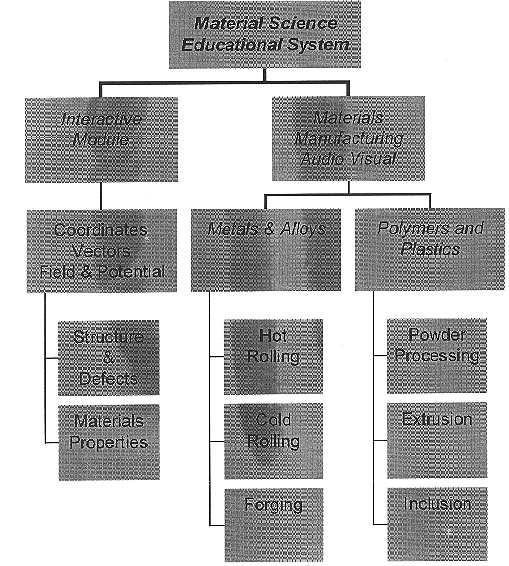
OPEN INTEGRATED EDUCATIONAL ENVIRONMENT
(OIEE)
FOR MATERIALS SCIENCE STUDENTS
ABSTRACT
The main objective of the Open Integrated Educational Environment (OIEE) presented in this paper, is to allow self training process. Materials Science is an interdisciplinary subject by nature. It needs interfacing between chemistry, physics, and engineering. There is a need for an open structure environment which allows student to add, update, and interact with the system contents. Materials selection and testing using computer represents an important element of the OIEE. There is also a need to meet special local demands which multi-media tool could serve such as languages, basic knowledges, etc. The OIEE will allow the undergraduate students to go through the course contents based on sequential tutorials and experiments. This open structure of the OIEE could also allow the postgraduate students to build and update their own interface tool and integrate it with the OIEE.
INTRODUCTION
Although computers and audio-visual-aids (AVA) have found some applications in teaching certain areas in materials science and engineering courses (MSEC), it is surprising that up till now, there are rather limited number of integrated media systems which apply these powerful tools in the classroom activities of teaching MSEC. An overview of the currently available AVA materials, including computer software, is presented by Gould [1].
The limitation of these applications is largely due to the major commitments required from the instructor in terms of time involvement, prior interdisciplinary background and comprehensive familiarity with computer hardware and software. Factors limiting the use of computers in MSEC teaching were presented in a number of surveys made in UK [2,3]. Again, a special emphasis was made on the various difficulties facing instructors in the preparation of different course materials including lack of time release from their institution, lack of technical support, lack of training, and lack of information regarding available materials. However, once made, the development of these courses would help to standardize the course content. It would also be very useful to promote self learning activities (SLA) among students. This is particularly beneficial within universities where large classrooms is the rule rather than the exception. Instead of relying only on conventional blackboard lecturing and tutoring, students are able to promote their special skills and contribute to the development of the course.
AVA can play an important role in many parts of the course which are descriptive rather than quantitative such as manufacturing and processing of different materials. They would also allow the use of native language as a commentary language in these parts, which will be an asset in any developing country.
One of the most attractive approaches in teaching materials microstructure components behavior is to make analogy between such behavior and one of the everyday life observation. For example, electron in the field of a nucleus can be explained by a person climbing certain number of stairs steps, where the energy expended depends on the number of steps down from the surface (zero energy). The usefulness of such figurative approach should not be underestimated and simple graphics using any of the available packages would be of help.
Because of the interdisciplinary nature of MSECs, people who are involved in the teaching process usually come from different disciplines including physicists, chemists, and engineers. Therefore, there is a need to develop a MSEC which, beside the full use of AVA and computer facilities, can also make use of the diverse experiences and teaching materials which come from such different disciplines. A typical MSEC may have the structure shown in figure (1).

Fig.1. A proposed MSEC structure
In the present paper a new approach for teaching MSEC is presented, the approach is concentrating on what is called interactive sequence display (ISD) and interactive tutorials (IT). The proposed MSEC is designed so as to fit into four modules :
MSEC MODULES
The aim of this work is to present an integrated modular approach for the development of an introductory course in MSE. Figure 2 represents the integrated structure and inter-relationships between different parts of the course together with the computer modules used to develop the course.
Modules # 1 and # 2 are explained in details with the aid of solving steps of typical examples and since most of the activities in the other modules are similar, only the additional activities in each of the other two modules are explained.
Module #1
The first module in this course consists of the necessary topics which are required to introduce to the student 3D material microscopic structures and practicing the 3D visualization. This visualization will be accompanied by the appreciation of the interaction between different components of the matter itself, electrically and magnetically.
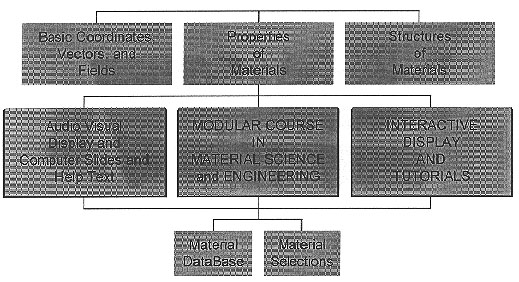
Fig. 2. Modular MSEC components up
Examples of topics covered by this module are : coordinate systems, electric and magnetic fields and potentials. This module will serve many basic courses such as electromagnetic theory, descriptive geometry, theory of mechanics, theory of structures, structure of solids, etc. The need for this basic module stems from our long experience in teaching, that an average student find it always difficult to fully understand courses which are based on coordinates, vectors and 3D analysis. It is therefore required to have a dynamic tool for displaying these concepts rather than conventional text books, static pictures, slides, etc. A computer-aided-tool (CAT) which contains animation, freezing the graph between steps, slow motion and interaction between the student and the program sequence control can be considered as an attractive and powerful tool in the teaching process. The dynamic build up of a graph through a series of sequential components is more helpful and interesting method as compared to direct display of the whole graph structure.
The concept of interactive display can be explained by an example such as how to locate a point in the space, determine its position vector, and how to calculate its unit vector. The required steps to do that are presented in figure 3 as four frames. It is worthwhile to mention here that, it is quite difficult to show the required four steps in one figure (as it will be displayed by the computer), especially in black and white, during writing the present paper and this explains the difficulty facing text books. The student can move from one step to the next using a click action. Using this approach, the full coverage of module 1 needs an extensive programming codes, even with the most recent computer visual languages kit, due to the presence of many special cases. This may be considered as a drawback and time consuming process. However, once it is done, it will provide a powerful tool for both the student and the instructor. Besides, the time and effort spent to construct such a module will be compensated by the application of this teaching material in several courses. Parallel to computer presentation and writing programming codes, AVA are introduced to display 3D structures with animation using one of the available 3D authoring tools.
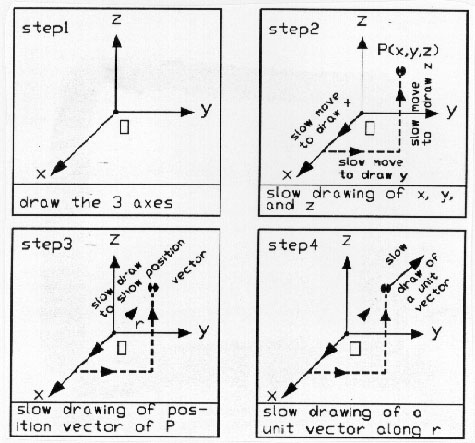
Fig.3. Four frames of the steps required to locate a point in Cartesian coordinate system, find its position vector and the unit vector. up
To help students for self evaluation, the module contains an interactive tutorial as a sub-module. It depends on a computer random generation of a coordinates, fields, or potential question, display it to the user, solve it graphically in a series of interactive steps (i.e. solved examples). Tutorials also presents a series of computer random generation of analytical problems and their solution steps (generated instantaneously). This allows correction and evaluation of students entries. In fact, and because of the specific nature of this module (problems can be divided into standard groups), the teacher will be able to introduce an infinite number of problems which help to explain its various aspects. There may be a need for the teacher to divide the class into standard groups where each group may deal with a certain type of problems. For other courses, this may require, at certain stage, the storing of formula, their parameters, and ranges. Somehow, this may be considered as an expert system.
Module #2
Module #2 addresses the main following topics:
a- General classification of materials.
This part is covered in a rather descriptive manner in which a special use is made of the AVA and ready made slides to present the differences between crystalline, polycrystalline, amorphous, polymeric and composite materials. A special emphasis is made on the clear presentation of the building blocks and their specific arrangement within each type.
b- In the second part, the structure and properties of materials are introduced by covering the basic concepts of bonding and crystal structures.
The Bravais space lattices, crystal planes and directions are explained and interactively displayed using a friendly driven menu. The module allows the student to review basic information through a help menu. It also make use of the different basic techniques applied in module 1. After reviewing this part, the module allows the student to generate random directions and planes within the different crystal systems with parallel self-assessment questions (multiple choices questions). ( an example is seen in figure 4).
c- Since many of the important properties of crystalline materials are determined by various existing imperfections within the structure, a significant part of this module is devoted to cover the different types of crystal defects with a programmed 3D visualization of each type.
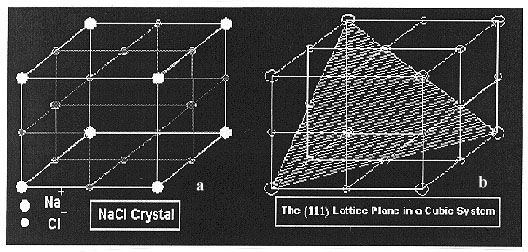
The role played by point defects in the diffusion processes within a solid is explained with the help of stored kinetic parameters. Computer animation is also used to present visual descriptions of certain concepts in this module. As an example, the movement of an edge dislocation under the influence of an applied stress was simulated so as to illustrate to the student the concept of a single atomic displacement and its contribution to the creation of a step and hence to crystal deformation as shown in figure (5). The useful rich colored schemes are used to illustrate the distribution of strain fields around the different types of dislocations.
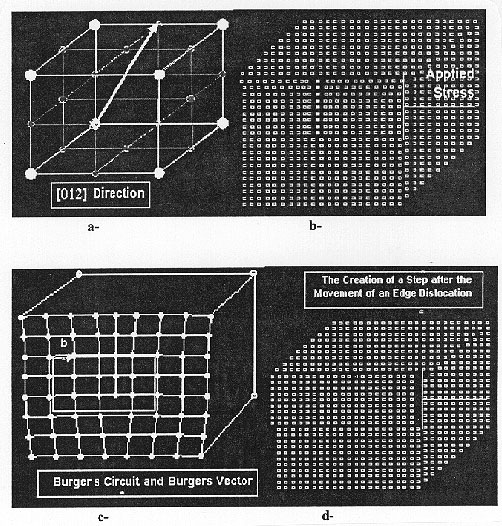
Tutorials applied to both module I and II are designed so as to control the number of times students are allowed to attempt solving any problem. It may also deny students access to the solution when this is found necessary. Using a comprehensive help menu, students can find a detailed explanation to different parts within each module and are thereby able to review the course materials before the problem solving session.
Modules #3 and #4
Module 3 deals with materials properties such as electrical, mechanical, optical, etc. The design of this module is straightforward, it does not involve too much coded graphics. The only graphics accompanying this module are those generated from parametric analysis, in this case any available spreadsheet tool can do it. The module contains a list of the material properties, their physical meanings, the effects of their parameters, and an engine to generate graphs showing the variations of the property with each parameter. In this case the weight of each parameter is appreciated by the student.
The new approach presented in this work is the interaction between module 3 and module 4 (materials database) which helps in material selections based on one or more of its parameters. The interaction between modules 3 and 4 may need some macros in order to relate the properties under experiment with all the material properties in the database. Using the database of module 4 along with the parameter formulas of module 3, the student can appreciate the concept of materials selection and how to match the proper material with his specific requirements.
SUMMARY
In this paper, a chart of the OIEE in materials science is proposed , the educational process is discussed, the different tools of the OIEE are presented, and the self evaluation techniques are analyzed.
REFERENCES
1. Gould, I.I., J. Mat. Educ., Vol. 11, 1989, p. 169
2. Gardner, N. and Darby J. Computer Educ., Vol. 15, 1990, p. 27.
3. Salkever M., Computerized Simithsonian Education Symposium, Smithsonian Institution,
Washington D.C., 6 June 1994.